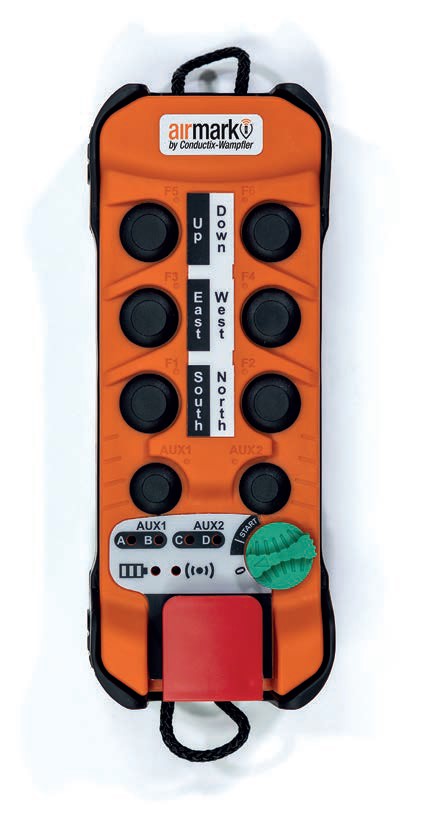How to pick a crane remote control
7 December 2023Brian Cook, senior product manager, Conductix-Wampfler USA, discusses how to pick the best crane remote for your business.
All businesses inevitably reach a point when it is time to leave old, outdated equipment behind and consider an upgrade to enhance operations. And one area you can make a seamlessly minor update but pack a significant business impact is your radio remote solution. For the industries and businesses that utilise overhead crane systems to carry out operations, such as automotive, aviation, manufacturing, and more, switching or upgrading to radio remote control systems can provide greater flexibility, enhance worker safety, and improve daily efficiency. These radio remotes can also support modernisation and innovation goals in facilities.
Upgrading and reevaluating equipment can surface many questions: how long will operators take to adapt to the new solution? How will this affect productivity? Is this product more user-friendly? Are there enough benefits to switching that outweigh the inconvenience and disruption? These questions are important to consider before moving forward with a new crane radio remote system.
If you’re ready to explore new options for your business to strengthen usability, improve efficiency, and boost employee safety, the remote radio space can feel overwhelming with many viable options. To help narrow down the best solution for your operations, ask yourself five questions:
1. What challenges does my team experience with our current crane radio remote product?
To begin the crane radio remote decision process, determine what pain points must be solved and lay out the capabilities needed for your specific cranes. For facilities looking to maximise lead time and functionality, source a crane radio system that is a durable, long-term investment. From a usability perspective, an overhead crane is an investment that can last around 20 years, so consider choosing a radio remote system that matches that longevity and is built to be long-lasting.
Another challenge in a facility environment is workforce turnover and training requirements. Within a facility, operators and managers will interact the most with radio interfaces as they drive and operate cranes. However, investing intentionally in your radio remote solution can set new employees up for success with a simpler and safer radio system. This is important because the manufacturing industry has a high employee turnover rate, with one report citing 39%. With high turnover rates, you need to onboard and train new employees as quickly as possible, and the easier the equipment is to learn, the better. Think about features that would make the radio remote the easiest to handle – like being ergonomically sound, having a simple interface and design, and being lightweight and easy to hold. Utilising a radio remote control system that caters to various users and operators eliminates the threat of downtime. The result is better usability and enhanced productivity.
2. What does the crane radio remote functionality look like for my business?
Next, consider what the total amount of radio usage will look like within your facility. To avoid needing a radio for every crane, consider a singular radio solution that includes the necessary applications to operate various cranes via one radio remote. By standardising functions on one radio solution, users can operate two cranes from one device to manage a tandem lift. When moving large loads in a facility, more than one crane is often needed. Crane radio remote systems with tandem functionality modes can connect two cranes to support and move extended loads to different areas. This means a more seamless workflow for crane operators and greater efficiency in moving necessary loads.
3. What does the replacement and repair process look like?
Radio transmitters drive data transfer and ensure the operation of your overhead cranes, so it is essential to source a radio solution that can be easily replaced when damaged or malfunctioning. Manufacturing facilities are typically fast-paced, harsh environments where accidents can happen, damaging transmitters and needing replacement. This leads to periods of downtime and ultimately reduces operational efficiency. To avoid these challenges, look to a radio remote system that makes crane pairing a seamless process without dropping power or requiring a manual lift to access a receiver for pairing mode.
4. How can a new solution increase safety for my operations?
Next, you’ll want to consider the safety implications of a new radio remote system. As more facility managers and operators move away from pendant controls and pushbutton stations, there is a greater opportunity for prioritising safety with radio remote systems. Pendant controls require users to work closer to cranes with cables tied to individual loads. However, radio solutions allow users to operate 360º around load areas, increasing general production throughput, boosting visibility and ensuring the safety of workers.
From a safety perspective, look for radio remotes that comply with Crane Manufacturers Association of America (CMAA) regulations if you’re in the US. Consider any add-ons that might be beneficial for your business, like lamps, horns, or other audible/visible indicators that signal a crane is in use. Some solutions provide your crane with start-up protection, featuring pin codes that allow you to type in the correct code needed for operation, which increases safety.
5. What do I need to consider when selecting a radio remote provider?
The last question to ask before making the switch to a new radio remote solution is what to look for in a long-term remote provider. Prioritise vendors that can provide you with a complete and tailored solution. While some partners try to sell you what they have, others showcase their robust portfolio of remote solutions that meet your facility’s needs. A true radio partner will provide data, power and control across all your crane applications and make upgrading your equipment seamless. There’s no one-size-fits-all when it comes to manufacturing, so find a partner that understands your business, pain points and goals for modern crane operations.
UPGRADE TO ENSURE MODERNISATION
While upgrading equipment can feel like an overwhelming process, it is a necessary step in innovating, strengthening your business operations, and bringing your cranes into the digital age. While there are countless ways to modernise your crane and facility operations, starting with your crane radio remote solution is a simple and effective way to bolster efficiency, improve usability, and enhance worker safety.

